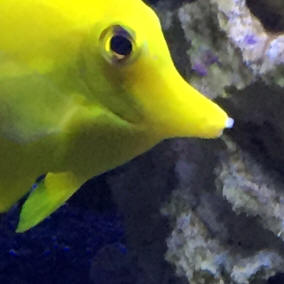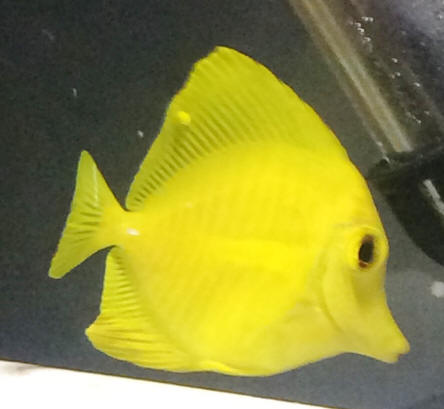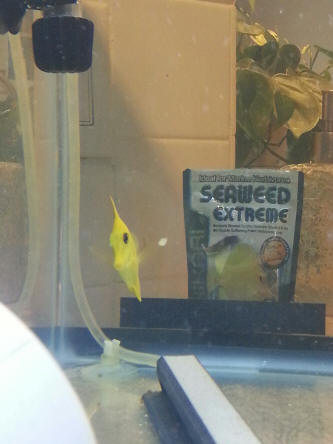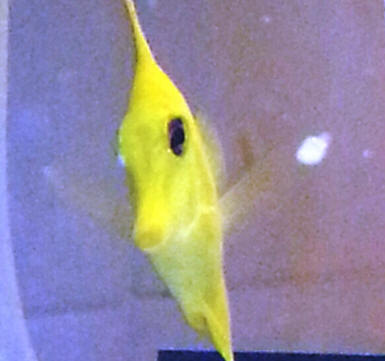FAQs about Yellow Tang
Disease/Health 14
FAQs on Yellow Tang Disease: Disease 1, Disease 2, Disease 3, Disease 4, Disease 5, Disease 6, Disease
7, Disease 8, Yellow Tang Disease 9, Yellow Tang Disease 10, Yellow Tang Disease 11,
Yellow Tang
Disease 12, Yellow Tang
Disease 13, & Paravortex/Black Spot
Disease,
FAQs on Yellow Tang Disease by Category:
Diagnosis,
Environmental, Nutritional,
Trauma,
Pathogenic (infectious, parasitic),
Social, Genetic,
Treatments
Related Articles: Yellow Tangs,Related FAQs:
Best Yellow Tang FAQs,
Yellow Tangs 1, Yellow Tangs 2, Yellow Tangs 3, Yellow Tangs 4, & Yellow Tang FAQs:
Identification, Behavior, Tang
Behavior, Compatibility,
Selection, Systems, Feeding, Reproduction, & Purple Tangs, Striped Sailfin Tangs, Zebrasoma Tangs, Zebrasoma Identification, Zebrasoma Behavior, Zebrasoma Compatibility, Zebrasoma Selection, Zebrasoma Systems, Zebrasoma Feeding, Zebrasoma Disease, Zebrasoma Reproduction, Surgeons In General, Tang
ID, Selection,
Compatibility,
Systems, Feeding, Disease, Fish Worms Diseases,
|

|
Surgeonfishes: Tangs for Marine Aquariums
Diversity, Selection & Care
New eBook on Amazon: Available here
New Print Book on Create Space: Available
here
by Robert (Bob) Fenner |
 |
Yellow tang breathing hard, getting skinny
Hi team,
I'm having a problem with a 4 inch yellow tang, and I'm wondering if you
could shed some light on it. I've had the tang for about 4
months now, in a 180 gallon FOWLR system. He's in there with a small
Maculosus angel, a
large Annularis angel, two large puffers (Porcupine and Stars and
Stripes),
<You know this last gets huge>
a Bicolor dwarf angel, and a large Desjardini Sailfin tang.
For about the last month the tang has been breathing hard (he's gilling
much more rapidly than he normally would) and isn't eating well. He no
longer eats the Spectrum pellets he once did. He only eats small pieces
of Nori and a few Spirulina brine shrimp here or there. He's hiding a
lot more than he should be, and he's getting pretty skinny.
There doesn't appear to be any ich or velvet present in the system (no
spots on him or the other fish, no scratching on rocks or sand, etc) and
from what I can tell he isn't being bullied. He's just breathing hard,
hiding a fair amount, and not eating very well. Any idea what's going
on?
<My first (and best) guess is gill flukes (do see WWM re); but the fish
may be just having a hard time competing for food and space here. IF it
were me, mine, I'd first try moving it to another established system and
increasing foods, feeding. Am hesitant to suggest treatment w/ a
practical anthelminthic in a FOWLR, as the die/kill-off of all worms may
be real
trouble. Do spend some time observing this fish during feeding... is it
getting its share? Bob Fenner>
Thanks,
Danny
Re: Yellow tang breathing hard, getting skinny
Thanks for the reply Bob.
<Welcome Dan>
To answer your question, no, the yellow tang is not getting its fair
share of food.
<Ahh; and you're likely aware that most tangs, including Zebrasomas, eat
most all the time during daylight hours>
It does not seem overly interested in eating or competing for food,
especially the Spectrum pellets I feed them every single day.
<A great product>
I've also noticed some reddening around its mouth.
<Aye ya; a bad sign>
I'm reading your take on flukes (below). Will a full-strength Cupramine
treatment eliminate them (I know it will any micro fauna on my liverock,
but I'd really prefer not to lose the yellow tang)?
<It will not... or more accurately, by the time the Copper poisons the
Flukes, the Tang will be gone. Need to use a purposeful vermifuge...
Prazi/quantel would be my first choice here. I do (of course) concur w/
all stated below. BobF>
Worms Phylum Platyhelminthes; flatworms, flukes, tapeworms.
Turbellarians, a group in the flatworm Phylum Platyhelminthes are mostly
"free-living" non-parasitic species. One notable exception is
Paravortex, the causative
agent of "black spot disease", notably of yellow tangs. This is easily
eliminated via freshwater dipping, though other authors suggest formalin
baths and organophosphate remedies. Turbellarians, a group in the
flatworm Phylum Platyhelminthes are mostly "free-living" non-parasitic
species. One notable exception is Paravortex, the causative agent of
"black spot disease", notably of yellow tangs. This is easily eliminated
via freshwater dipping, though other authors suggest formalin baths and
organophosphate remedies. Trematodes, the flukes are divided into
ecto-parasitic (external)
monogenes and the largely endo-parasitic (internal) Digenes on the basis
of their life histories. Monogeneans have a direct life cycle, and
digeneans an indirect one with the use of one or more intermediary host
species. The monogenes are important as gill and body parasites of
marine fishes. There are many species of flukes, they are common on
imported livestock, and may significantly reduce their health if not
eliminated through acclimation techniques. Hiding, rapid breathing
discoloration and more are symptomatic of infection/infestation, though
microscopic examination of skin scrapings and gill clippings are
required for positive diagnosis. Several chemicals including
organophosphates, copper, quinines and dips of freshwater with/out
malachite/formalin have been described in the literature as being
efficacious. Recent authors tout the use of Praziquantel (Droncit (R))
at 1ppm in a treatment system. Digeneans rarely spread due to the
absence of intermediaries, and many of the monogenes are species/group
specific.
|
Lympho, or something else?
1/13/16
Hi Crew!
I have recently purchased a yellow tang - online, as there are no saltwater fish
stores within an hour of me. When the little guy came, he was a beautiful bright
yellow, but seemed very emaciated, and had this spot on his fin. He started
eating around day 3 in QT, and is quickly filling out and becoming a pig, eating
anything I toss in. I had initially thought he wouldn’t make it, but he seems to
be rebounding nicely. After searching the site today, I’m thinking this is
probably Lympho, but the fact that it is the same yellow as his fins (instead of
white) makes me want to double check with you.
<Might be Lymphocystis... can't tell from your pic... >
Thanks for the help, and the wonderful info on the site! You guys definitely
help us all out so much!
~ TJ
<Could be a number of influences at play here. Please search, read on WWM re
Zebrasoma, Z. flavescens health and more on WWM. Bob Fenner>
|
 |
|
yellow tang large white clump on fin 11/26/15
my yellow tang has a large white clump on his fin its kinda hanging off but
still attached can you please help me identify and how to treat it
thanks
April
<Mmm; can't quite make this out; but appears to be a "wound site"... rather than
something pathogenic. I would not move this fish, add medicines; but do your
best to bolster health through good nutrition (soaking foods per WWM) and
optimized environment (water quality). Bob Fenner>
|


re: yellow tang large white clump on fin
11/27/15
it started out small (spec of salt) and has grown to the size of half a
pea, within the past month. I have noticed the past day that it is starting to
fall away
<Look up Lymphocystis on WWM. Does this appear to be similar? BobF>
|
|
|

